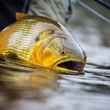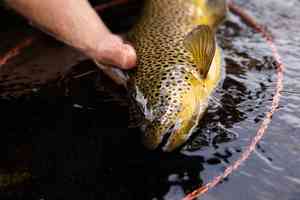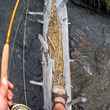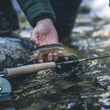I don’t consider myself a good dry fly fisherman. Not in the least. In fact, I spend most of my time nymphing, fishing wet flies and underperforming with streamers. Part of the reason my dry fly skills aren’t what I’d like them to be is a result of the fact that I don’t get as much time on the water as I’d like during the spring and summer hatches. Despite Pennsylvania being a wonderful trout fishing state, most of the state’s best fishing is over three hours from my doorstep, and the streams and rivers that exist in between don’t present what you’d call either clockwork or blanket hatches, so hitting them with any regularity takes a considerable bit of effort.
When I do find myself on the water during a good hatch, I do okay. I’m not splashing flies down on the surface and spooking entire pools. But, I’ll easily get outfished by the dry fly aficionado that doesn’t so much as carry split shot or even have a woolly bugger in his box and who spends all year casting exclusively dries, perfecting his reach cast. And that’s fine with me.
Given the above, I’m not typically eager to criticize other fishermen’s tactics for fishing bugs on or near the surface. Yet, whether the other fishermen I observe are obvious veterans or relative beginners, I’m repeatedly struck by the one-dimensional approach the vast majority of those fishermen take when fishing their flies and hoping to entice a trout to rise from where it is holding and snatch up their offering.
Perhaps it shouldn’t come as a surprise. Most of us are taught that successful fly fishing revolves entirely around the dead drift. Cast your line, your fly and get it onto the water. After that, let the river take control and do your job as the fisherman to remove entirely your influence on the fly as it travels downriver. This is often what’s called for. This is often what’s best. And in those situations, if I’m not the only dry fly fisherman on the water, there’s a fair chance I’m getting outfished.
Yet, if time on the water should teach us anything, it should teach us that there are no rules, only guidelines, and that constantly learning and adapting is the only real key to success. What we were all taught was just that, a set of guidelines, even if those doing the teaching thought otherwise. Fish do as they please and it is safe to say they haven’t read the rulebook many fishermen insist on playing by.
The point of all of this is to say that there are many situations in which laying down a clean cast and getting out of the way isn’t the best approach. These situations vary and range from a heavy blanket hatch where the angler can be rewarded for distinguishing his bug from the naturals to still spring creeks where educated fish have seen it all, and everything in between. In these situations, giving your fly some action, breathing a bit of life into it is often the better choice.
Being successful with this alternative approach is heavily dependent on the whole “bit” part. Anglers who experiment with breathing life into their flies and fail often abandon the approach quickly, deeming it ineffective. In my somewhat limited experience, their lack of success is most often tied to their method. We’re not talking about rocket launching your flies from the surface film to a point that is the mayfly equivalent of miles away from their origin. We’re not even talking about skating caddisflies, which is in itself a relatively subtle tactic. What we’re attempting to do is impart a very subtle motion to our otherwise dead-drifting fly.
Every fisherman I know that successfully employs this tactic does so via a slightly different method. A fine trout fisherman I know that spends virtually all of his time plying the waters of Oregon’s Deschutes River does so by ever-so-slightly twitching the tip of a raised rod, a good friend of mine does so by micro-stripping the fly line, while a guide I fished with in Alaska does so by weakly pumping the elbow of his rod arm on a rod that holds a gently slack line.
The key to each of these methods is their subtlety: the rod tip twitch is almost imperceptible, perhaps a half inch or so; the micro-strip is truly micro, completed using only the thumb and forefinger, the line is held fast the whole time, while the line is both pushed then pulled, returning the line quickly to its original position; and likewise for the elbow pump. The result of each of these methods is a tiny twitch in the fly at the end of the angler’s line. And when the situation calls for it, the benefits can be dramatic.

While fishing tiny dries for big, but mostly yet-to-fatten-up rainbows during a three hour evening session on an Alaskan River (yes, dry flies in Alaska) in the Bristol Bay region this summer, all four boats — each holding two anglers — were struggling to do more than pick up the occasional fish, despite there being no shortage of risers to target. All eight of us were fishing down and across, feeding line out as our flies drifted, leading to impossibly long drifts. But the fish were being picky. After I took a healthy 22-inch rainbow on voracious rise, we were clued in on the need for a change in approach. As it turns out, I had “messed up” my drift while by fumbling with a cigarette instead of smoothly feeding line and allowing the fly to continue its uninterrupted drift. Instead, the fly jerked just a bit, and then continued its drift. Immediately thereafter, the big rainbow — who I hadn’t even been targeting— rose from the depths and slashed the fly off the surface. Needless to say, we breathed just a bit of life into the remainder of our drifts that evening and were rewarded, bringing 6 more rainbows to the boat in the less than half hour that remained in the evening while the guys in the other boats stayed their previous course and brought only a few more fish to hand between the three boats.
It's worth restating that often, even perhaps most often, the dead-drifted dry may offer up your best chances for success. The important thing is to approach every situation with an open mind and, even if you don’t have a playbook of game plans or proven alternative approaches, be willing (perhaps even eager) to toss the rules aside and experiment. The fish will reward you for it, albeit not always, and you’ll grow more as an angler as a result.






























Comments
mkjames replied on Permalink
Question authority!
Seriously. There's no doubt that moving outside the box pays dividends. I've yet to perfect this particular method myself, but I'm always fooling around when I'm on the water, and am obviously surprised at the results.
ginkthefly replied on Permalink
Do you move your dries only when fishing down and across as described in the article?
Chad Shmukler replied on Permalink
Not me personally, though others may limit it to down-and-across presentations. That said, I am most comfortable doing so -- and thus most often would chose to -- when presenting down and across. I think this is simply because there's less slack in the equation during such a presentation, and thus a greater sense of control.
Spencer replied on Permalink
There's no doubt that imparting action to a dry fly often brings a strike...especially caddis patterns.
mattbenton replied on Permalink
I have had fish ignore a fly on a dead drift, only to hit it as I strip it back upstream to make another cast (it is worth noting these were not mature fish). Many times this has happened my fly was completely submerged, a few inches below the surface. Point being, you never quite know what a fish will do and while tried and true methods certainly got that way for a reason, experimentation can sometimes yields results.
Aileen Lane replied on Permalink
Great article. I guess I'm doing ok casting it here and there seeing what would work and attract the fish. lol Got to think outside the box.
Marc Barnwell replied on Permalink
Here in Western Colorado, I throw dries irregardless if there is a so called "hatch" happening which basically means the majority of the time. Even if you don't see bugs flying around and you don't see rising fish, throw dries and see what happens you might be in for a nice surprise!
Brian Bean replied on Permalink
Great article!
Jon replied on Permalink
I'm such a bad dry fly fisher that I've taken more fish on swung, drowned flies than when they were drifting. For years, I thought the elk hair caddis in my box was a tiny muddler and you know what? I consistently caught fish on it.
Gerry Crow replied on Permalink
Nice article. And another prime example of why I stopped subscribing to FF mags a long time ago. Writers seem to constantly restate old techniques as new revelations that will change your fly fishing life. As soon as I read this article I recalled a technique known as "the sudden inch" first popularized in 1972 by author Leonard Wright. Other writers have "discovered" this technique, some with attribution to Wright, others claiming ownership. Who knows, did Wright dust off an old technique, give it a catchy name and claim it as his own? I suppose along around 2038 another article will appear espousing the equivalent of the sudden inch as the best thing since sliced bread. Like Peter Allen's song, "Everything old is new again."
Pages